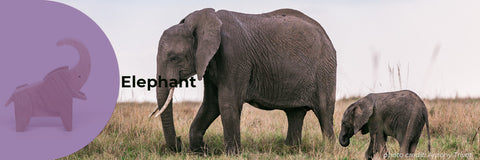Our experience has shown that the African animals are children’s favorite. Even though we didn’t have this fact in mind when we created our first collection, Animal Kingdom, back in 2013, this collection has become our all-time bestseller. Elephant, Rhino, Giraffe, Monkey and Lion are the first animals that we crafted. We put them together in a collection and only then did it dawn on us that they were all emblematic African species. With our African collection - Animal Kingdom - of eco-friendly, entirely handmade and sustainable animal puzzles, we take a bow to these majestic animals that will forever be royalties, both in the animal kingdom and in kids’ world. Here are some stories you can tell to your children about the African royal family.
Elephants are the largest mammals on Earth. They can weigh up to 7 tons. They are distinguished by their large bodies and their trunks. Elephants are extremely emotional creatures but, sadly, nowadays they are critically endangered. In the last 50 years their population has decreased by 60%.
- An elephant's trunk weighs 181 kg (400 pounds), but elephants can pick up things as small as a single grain of rice with it. They drink, pick up things and even communicate with their trunks. They use their trunks as snorkels when they swim. They interlock trunks to say hello to each other.

photo credits: Kritsada Seekham
- Elephants can recognize themselves in the mirror. Along with humans, apes, and dolphins they are among the few animals with self awareness. They are extremely emotional creatures — elephants even grieve for lost family members and are known to cover dead animals they come across with stones and branches as if burying them. There are also theories that when elderly elephants become weak and feel it is time to pass on, they instinctively direct themselves away from the group to die alone in the so-called elephant graveyards, places where scientists have found several skeletons grouped together.
- Elephants’ eyelashes are up to 13 cm (5 inches) long. In fact, they are the animals with the longest eyelashes in the world.

photo credits: Ana Tarazevich
- They can spend as long as 16 hours a day feeding.
- They're the only mammals that can't jump — even when they're running, elephants always have at least one foot on the ground. They are just too heavy— plus, they can stand on their tippy toes.
- Elephants are pregnant for 22 months — it's the longest gestation period of any mammal. Baby elephants are born blind and weigh 118kg(260 pounds). They suck their trunks for comfort like human babies suck their thumbs.

Photo credits: Alexas Fotos

Photo credits: Katie Hollamby
- The oldest elephant known lived to be 86.

Photo credits: Harvey Sapir
Populations of elephants are finding it harder to follow their traditional migration routes to reach water, feeding and breeding grounds, and they’re coming into often dangerous contact with people. Elephants are affected by the illegal wildlife trade, habitat loss and humans.
Because of poaching for ivory and loss of habitat, the African forest elephant is now listed as Critically Endangered and the African savanna elephant as Endangered. Around 90% of African elephants have been wiped out in the past century - largely due to:
- Poaching: The number of African forest elephants fell by more than 86% over a period of 31 years, while the population of African savanna elephants decreased by at least 60% over the last 50 years. Both species suffered sharp declines since 2008 due to a significant increase in poaching, which peaked in 2011 but continues to threaten populations.
- Lost habitat: Other major threats to both African elephant species include the ongoing conversion of their natural habitats for agriculture and other land uses.

Photo credits: Gillian Harrison
Elephants play an essential role in their environment. They're ‘landscape architects’ which means that, for instance, as they move around and feed, they create clearings in wooded areas, which lets new plants grow and forests regenerate naturally. And then there’s seed dispersal. When elephants eat seed-bearing plants and fruits, the seeds often re-emerge undigested. It’s the way a lot of plants spread. And elephants can eat big seeds that small animals can’t. Without elephants, the natural structure and functioning of their landscapes would be very different, which would have impacts on the other wildlife and on the people who share that space.
We often say that we want to design toys that last for several generations and that is how we understand sustainability. You can imagine how concerned we feel about this sad situation. By telling the elephant's story and consciously producing our wooden magnetic toys we want to contribute to protecting these beautiful animals and their environment. We want them to be with us for the generations to come.
sources: INSIDER, WWF


